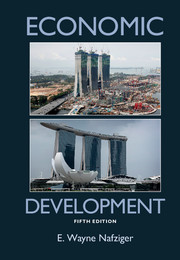Book contents
- Frontmatter
- Contents
- Preface to the Fifth Edition
- Abbreviations and Measures
- Part One. Principles and Concepts of Development
- Part Two. Poverty Alleviation and Income Distribution
- Part Three. Factors of Growth
- Part Four. The Macroeconomics and International Economics of Development
- 14 Monetary, Fiscal, and Incomes Policies and Inflation
- 15 Balance of Payments, Aid, and Foreign Investment
- 16 The External Debt and Financial Crises
- 17 International Trade
- Part Five. Development Strategies
- Glossary
- Bibliography
- Index
- Endpapers
- References
16 - The External Debt and Financial Crises
from Part Four. - The Macroeconomics and International Economics of Development
Published online by Cambridge University Press: 05 June 2012
- Frontmatter
- Contents
- Preface to the Fifth Edition
- Abbreviations and Measures
- Part One. Principles and Concepts of Development
- Part Two. Poverty Alleviation and Income Distribution
- Part Three. Factors of Growth
- Part Four. The Macroeconomics and International Economics of Development
- 14 Monetary, Fiscal, and Incomes Policies and Inflation
- 15 Balance of Payments, Aid, and Foreign Investment
- 16 The External Debt and Financial Crises
- 17 International Trade
- Part Five. Development Strategies
- Glossary
- Bibliography
- Index
- Endpapers
- References
Summary
Scope of the Chapter
Chapter 15 mentioned that the less-developed countries’ (LDCs’) persistent deficit on the balance on goods, services, and income through the 1980s and 1990s, together with a decline in loans at bankers’ standards in the mid- to late 1990s, contributed to a continuing LDC debt crisis. The debt crisis for Latin America and other middle income borrowers, primarily owed to commercial lenders, was of a different nature from that of sub-Saharan Africa, who owed its debts primarily to bilateral government and multilateral lenders. Nongovernmental organizations put pressure on the World Bank, International Monetary Fund (IMF), and developed country (DC) donors to relieve, write-down, or forgive the debts of the highly indebted poor countries (HIPCs), largely from Africa. Although the 2007–9 global recession affected both DCs and LDCs, the debts for LDCs were probably more burdensome.
The most fundamental change in the international economic system in the 1990s was the incredible rise in international capital mobility, with about two trillion dollars crossing borders daily (You 2002:216), from which middle-income countries (MICs) received massive capital inflows. Global foreign-exchange transactions rose from a mere $15 billion per day in 1973 to $60 billion in 1983, exploding to $900 billion in 1992 and $4 trillion in 2007, and continuing to increase in the years after that. Thus, the worldwide ratio of foreign-exchange transactions to world trade was 9:1 in 1973, 12:1 in 1983, 90:1 in 1992, and 360:1 in 2010. In 2010, the global gross national product (GNP) was $200 billion, exports were $60 billion, and foreign-exchange transactions were $75 trillion daily, far in excess of the foreign-exchange reserves of the world's central banks, $300 trillion, which is inadequate to cope with sudden shifts in the direction of global currency flows (Nayyar 1997:3–4 updated). Not surprisingly, financial crises occurred in Mexico (1994); Thailand, Indonesia, Korea, and East Asia generally (1997–9); Brazil and Russia (1998); and Argentina (2001–3), following capital-account liberalization and substantial increases in capital inflows.
- Type
- Chapter
- Information
- Economic Development , pp. 532 - 570Publisher: Cambridge University PressPrint publication year: 2012



